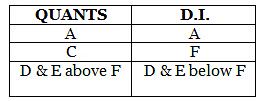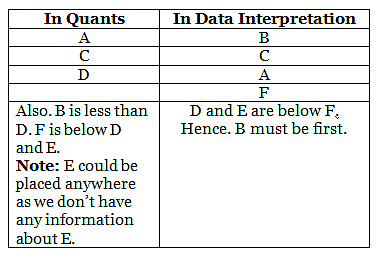Introduction & Level Wise Examples: Ranking | Logical Reasoning (LR) and Data Interpretation (DI) - CAT PDF Download
| Table of contents |

|
| Introduction |

|
| How to Solve |

|
| Solved Examples: Level of Difficulty 1 |

|
| Solved Examples: Level of Difficulty 2 |

|
Introduction
Reasoning questions on Rankings involve an ordering of people/objects based on their heights/weights/performance in an exam, etc. As name suggests, in questions on rankings you are supposed to place people/objects in a decreasing or increasing order based on the attribute being measured. Following are the key skills required in Logical reasoning questions based on rankings:
Visualization of Structure: The ability to mentally construct the structure in which rankings need to be established.
Ordering Clues: The ability to arrange clues in the correct order of usage, as per the principles of logical reasoning.
Understanding Indirect Clues: The capability to grasp the meaning of indirect clues and identify the appropriate stage in problem-solving to apply them.
Conversion of Clues into Visual Cues: Proficiency in translating clues from language form to visual cues, facilitating a comprehensive view of all clues without repeated reading.

How to Solve
These skills collectively aid in efficiently solving logical reasoning questions based on rankings.
Example: Directions for Questions 1 to 4 (Constraint-Based Arrangement):
(i) Six students A, B, C, D, E and F participated in a self-evaluation test of Quants and Data Interpretation (D.I.).
(ii) The total marks of A in Quants was just above C and in D.I., just above F.
(iii) B was just above C in D.I. but he scored less than D in Quants.
(iv) F got more marks than D and E in D.I. but did not perform as well in Quants as in D.I. as compared to D and E.
(v) No one is in between C and D in Quant and C and A in D.I.
Q1: Who got the highest marks in D.I.?
(а) A
(b) B
(c) C
(d) Data inadequate
Q2: Which of the following students has scored the least in D.I.?
(a) Only D
(b) Only E
(c) Only D or E
(d) None of these
Q3: Who was just below D in Quants?
(а) B
(b) E
(c) C
(d) Data inadequate
Q4: Which of the given statements is not necessary to answer the questions?
(a) (ii)
(b) (iii)
(c) (iv)
(d) All are necessary
Reaction Tracker
From the second statement, we have:
From statement (iii),
We have B just above C in D.I. and B somewhere below D in Quants. At this point, our figure remains the same as we cannot put this information into the figure.
 From Statement (iv), we have:
From Statement (iv), we have:
From Statement (V), we have:

This leads us to the following table:
 The answers are:
The answers are:
- Sol 1 : Option (b) is correct.
- Sol 2: Option (c) is correct.
- Sol 3: Option (d) is correct.
- Sol 4: Option (d) is correct.
Solved Examples: Level of Difficulty 1
Directions for Questions 1 to 3: Refer to the following information to answer the questions that follow.
(i) Seven students A, B, C, D, E, F and G take a series of tests.
(ii) No two students get similar marks.
(iii) G always scores more than A.
(iv) A always scores more than B.
(v) Each time either C scores the highest and E gets the least, or D scores the highest and For B scores the least.
Q1: If G is ranked fifth, which of these must be true?
(a) D scores the highest.
(b) C is ranked second.
(c) E is ranked third.
(d) B is ranked fourth.
Sol: Option (a) is correct.
Explanation: If G is fifth, then A and B must be ranked 6" and 7th respectively. This can only happen if D scores the highest (as, if C is the highest, then E must be 74).
Q2: If D is ranked second, which of the following can be true?
(a) A gets more than C.
(b) G gets more than D.
(c) A gets more than G.
(d) F gets more than G.
Sol: Option (d) is correct.
Explanation: The first three options are not feasible.
Q3: If D is ranked sixth and B is ranked fifth, which of these can be true?
(a) G is ranked first or fourth.
(b) C is ranked second or third.
(c) A is ranked second or fifth.
(d) F is ranked third or fourth.
Sol: Option (d) is correct.
Solved Examples: Level of Difficulty 2
Directions for Questions 1 to 5: Answer the questions on the basis of the information given below.
Four cricketers Salman, Raiwan, Kaushal and Gautam are ranked 1 to 4, based on their performance in the test matches played by them. The following information is also known:
(i) If Salman is ranked 1, then Raiwan is not ranked 3.
(ii) If Raiwan is not ranked 1, then Gautam is ranked 4.
(iii) If Kaushal is ranked 3, then Gautam is not ranked 2.
(iv) If Kaushal is not ranked 2, then Gautam is ranked 2.
(v) If Gautam is ranked 3, then Salman is not ranked 4.
Q1: What is the rank of Salman?
Sol: 3
Q2: Who is ranked 1 among the four cricketers?
(a) Raiwan
(b) Kaushal
(c) Salman
(d) Cannot be determined
Sol: Option (a) is correct.
Q3: Who is ranked 4 among the four cricketers?
(a) Raiwan
(b) Gautam
(c) Kaushal
(d) Cannot be determined
Sol: Option (d) is correct.
Q4: The ranks of how many of the four cricketers can be determined?
Sol: 2
Q5: What is the sum of all possible ranks of Gautam and Kaushal?
Sol: 4 + 2 + 2 + 4 = 12.
Solutions for Questions 1 to 5:
From the 4th information, it can be deduced that either Kaushal or Gaurav would be ranked 2.
Case 1: Dhawan is ranked 2.
If Salman is ranked 1 then Raiwan is ranked 4 (by the 1st information). But it is contradicted (by the 2nd information). So Salman is not ranked 1. By the 2nd information, if Raiwan is not ranked 1, then Gautam is ranked 4, Raiwan is ranked 3 and Salman is ranked 1, which is not possible. So, Raiwan is ranked 1. Gautam can be ranked 3 but then Salman is ranked 4, which contradicts the 5th information. So, Gautam is ranked 4 and Salman is ranked 3.
Case 2: Gautam is ranked 2. As seen before, Salman can't get rank 1. So, Raiwan is ranked 1. From the 4th information, Kaushal can't be ranked 3 as in that case Gautam can't be ranked 2. So, Kaushalis ranked 4 and Salman is ranked 3.
Directions for Questions 6 to 10: Answer the questions on the basis of the information given below.
A, B, C, D, E, F, and G are seven persons who travel to the office every day by a particular train which stops at only five stations – I, II, III, IV, and V respectively after it leaves the base station. Three among them get on the train at the base station. D gets down at the station next at which F gets down. B does not get down either with E or A. At station III; G alone gets in and gets down with C after one station. A travels between two stations only and gets down at station V. No one gets in at station II. F gets in with C. C does not get in with either B or D. E gets in with two others persons and gets down alone after D. B and D work together in the same office and they get down together at station III. None gets down at station I.
Q6. At which station does E get down of the train?
a) II
b) III
c) IV
d) None of the above
Sol: Option (b) is correct.
Q7. At which station do C and F get in together?
a) I
b) II
c) III
d) Data inadequate
Sol: Option (d) is correct.
Q8. At which station do B and D get in?
a) I
b) Base station
c) III
d) Data inadequate
Sol: Option (d) is correct.
Q9. After how many stations does E get down?
a) One
b) Two
c) Three
d) Four
Sol: Option (c) is correct.
Q10. After how many stations does E gets down at which F gets down?
1) One
2) Two
3) Three
4) Four
Sol: Option (b) is correct.
|
77 videos|180 docs|96 tests
|
FAQs on Introduction & Level Wise Examples: Ranking - Logical Reasoning (LR) and Data Interpretation (DI) - CAT
| 1. What is the importance of ranking in the CAT exam? |  |
| 2. How can I improve my ranking in the CAT exam? |  |
| 3. What types of questions are included in the CAT exam ranking section? |  |
| 4. Are there any specific strategies for solving ranking problems in the CAT exam? |  |
| 5. How does the sectional weightage impact my overall CAT ranking? |  |




















